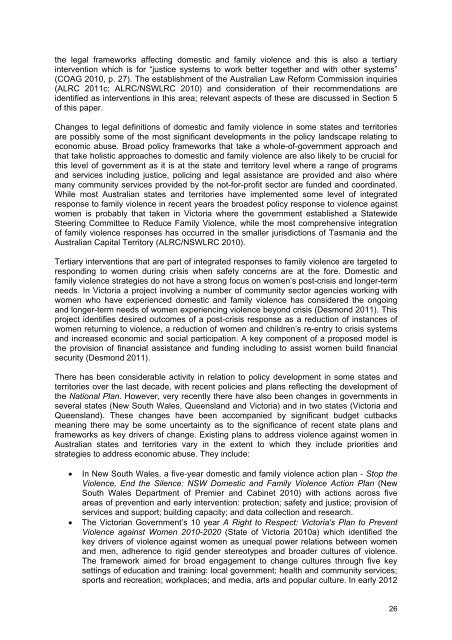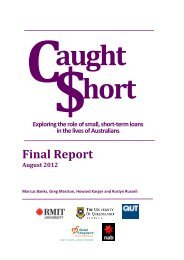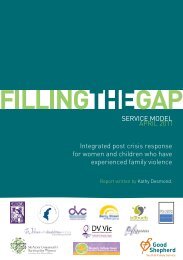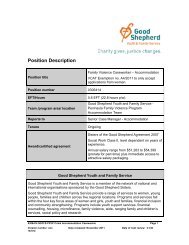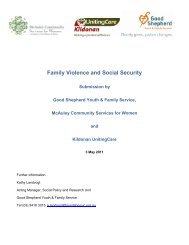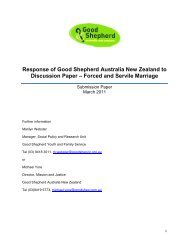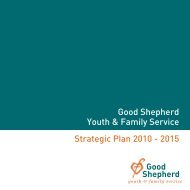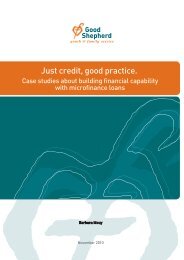Spotlight on Economic Abuse: a Literature and Policy Review
Spotlight on Economic Abuse: a Literature and Policy Review
Spotlight on Economic Abuse: a Literature and Policy Review
Create successful ePaper yourself
Turn your PDF publications into a flip-book with our unique Google optimized e-Paper software.
the legal frameworks affecting domestic <strong>and</strong> family violence <strong>and</strong> this is also a tertiary<br />
interventi<strong>on</strong> which is for “justice systems to work better together <strong>and</strong> with other systems”<br />
(COAG 2010, p. 27). The establishment of the Australian Law Reform Commissi<strong>on</strong> inquiries<br />
(ALRC 2011c; ALRC/NSWLRC 2010) <strong>and</strong> c<strong>on</strong>siderati<strong>on</strong> of their recommendati<strong>on</strong>s are<br />
identified as interventi<strong>on</strong>s in this area; relevant aspects of these are discussed in Secti<strong>on</strong> 5<br />
of this paper.<br />
Changes to legal definiti<strong>on</strong>s of domestic <strong>and</strong> family violence in some states <strong>and</strong> territories<br />
are possibly some of the most significant developments in the policy l<strong>and</strong>scape relating to<br />
ec<strong>on</strong>omic abuse. Broad policy frameworks that take a whole-of-government approach <strong>and</strong><br />
that take holistic approaches to domestic <strong>and</strong> family violence are also likely to be crucial for<br />
this level of government as it is at the state <strong>and</strong> territory level where a range of programs<br />
<strong>and</strong> services including justice, policing <strong>and</strong> legal assistance are provided <strong>and</strong> also where<br />
many community services provided by the not-for-profit sector are funded <strong>and</strong> coordinated.<br />
While most Australian states <strong>and</strong> territories have implemented some level of integrated<br />
resp<strong>on</strong>se to family violence in recent years the broadest policy resp<strong>on</strong>se to violence against<br />
women is probably that taken in Victoria where the government established a Statewide<br />
Steering Committee to Reduce Family Violence, while the most comprehensive integrati<strong>on</strong><br />
of family violence resp<strong>on</strong>ses has occurred in the smaller jurisdicti<strong>on</strong>s of Tasmania <strong>and</strong> the<br />
Australian Capital Territory (ALRC/NSWLRC 2010).<br />
Tertiary interventi<strong>on</strong>s that are part of integrated resp<strong>on</strong>ses to family violence are targeted to<br />
resp<strong>on</strong>ding to women during crisis when safety c<strong>on</strong>cerns are at the fore. Domestic <strong>and</strong><br />
family violence strategies do not have a str<strong>on</strong>g focus <strong>on</strong> women’s post-crisis <strong>and</strong> l<strong>on</strong>ger-term<br />
needs. In Victoria a project involving a number of community sector agencies working with<br />
women who have experienced domestic <strong>and</strong> family violence has c<strong>on</strong>sidered the <strong>on</strong>going<br />
<strong>and</strong> l<strong>on</strong>ger-term needs of women experiencing violence bey<strong>on</strong>d crisis (Desm<strong>on</strong>d 2011). This<br />
project identifies desired outcomes of a post-crisis resp<strong>on</strong>se as a reducti<strong>on</strong> of instances of<br />
women returning to violence, a reducti<strong>on</strong> of women <strong>and</strong> children’s re-entry to crisis systems<br />
<strong>and</strong> increased ec<strong>on</strong>omic <strong>and</strong> social participati<strong>on</strong>. A key comp<strong>on</strong>ent of a proposed model is<br />
the provisi<strong>on</strong> of financial assistance <strong>and</strong> funding including to assist women build financial<br />
security (Desm<strong>on</strong>d 2011).<br />
There has been c<strong>on</strong>siderable activity in relati<strong>on</strong> to policy development in some states <strong>and</strong><br />
territories over the last decade, with recent policies <strong>and</strong> plans reflecting the development of<br />
the Nati<strong>on</strong>al Plan. However, very recently there have also been changes in governments in<br />
several states (New South Wales, Queensl<strong>and</strong> <strong>and</strong> Victoria) <strong>and</strong> in two states (Victoria <strong>and</strong><br />
Queensl<strong>and</strong>). These changes have been accompanied by significant budget cutbacks<br />
meaning there may be some uncertainty as to the significance of recent state plans <strong>and</strong><br />
frameworks as key drivers of change. Existing plans to address violence against women in<br />
Australian states <strong>and</strong> territories vary in the extent to which they include priorities <strong>and</strong><br />
strategies to address ec<strong>on</strong>omic abuse. They include:<br />
<br />
<br />
In New South Wales, a five‐year domestic <strong>and</strong> family violence acti<strong>on</strong> plan ‐ Stop the<br />
Violence, End the Silence: NSW Domestic <strong>and</strong> Family Violence Acti<strong>on</strong> Plan (New<br />
South Wales Department of Premier <strong>and</strong> Cabinet 2010) with acti<strong>on</strong>s across five<br />
areas of preventi<strong>on</strong> <strong>and</strong> early interventi<strong>on</strong>: protecti<strong>on</strong>; safety <strong>and</strong> justice; provisi<strong>on</strong> of<br />
services <strong>and</strong> support; building capacity; <strong>and</strong> data collecti<strong>on</strong> <strong>and</strong> research.<br />
The Victorian Government’s 10 year A Right to Respect: Victoria's Plan to Prevent<br />
Violence against Women 2010-2020 (State of Victoria 2010a) which identified the<br />
key drivers of violence against women as unequal power relati<strong>on</strong>s between women<br />
<strong>and</strong> men, adherence to rigid gender stereotypes <strong>and</strong> broader cultures of violence.<br />
The framework aimed for broad engagement to change cultures through five key<br />
settings of educati<strong>on</strong> <strong>and</strong> training: local government; health <strong>and</strong> community services;<br />
sports <strong>and</strong> recreati<strong>on</strong>; workplaces; <strong>and</strong> media, arts <strong>and</strong> popular culture. In early 2012<br />
26


